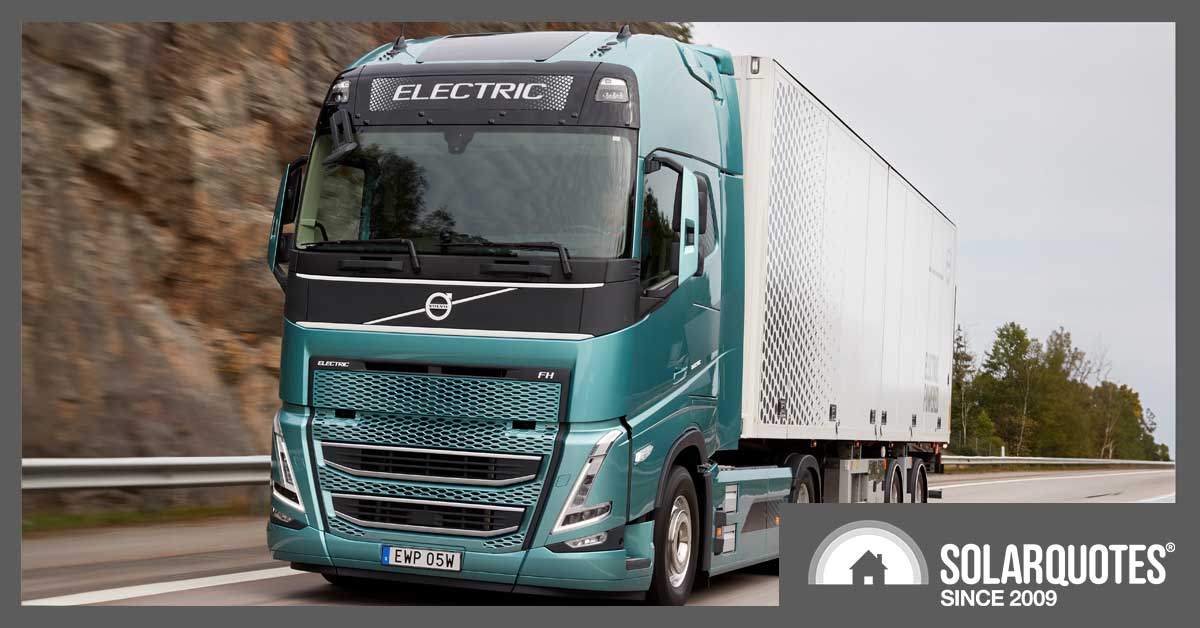Volvo is showing off its electric trucks, although Australian design rules need to be changed before they’re sold here. Volvo says it wants to manufacture them in Brisbane.
Two vehicles have hit the showrooms so far. There’s the 44-tonne FH Electric: it’s got three electric motors delivering 490kW of power; or there’s the FE Electric, a 27-tonne machine with two electric motors delivering 225kW. Each has battery configurations for up to 300km range.
The trucks put the batteries where diesel fuel tanks are usually installed, with the motors between the chassis rails.
Volvo has operated a manufacturing facility in the south-east Brisbane suburb of Wacol since 1972, and as of 2027, the Swedish truck maker wants to build electric trucks there.
In a media release, Volvo Trucks Australia VP Gary Bone said:
“Being able to engineer and implement these vehicles locally will allow us to work with closely with our customers as they move towards zero emissions transport over the next decade.”
This piece from the RACQ quotes Volvo Group Australia’s president Martin Merrick saying the 300km range, while unsuitable for long-haul routes, would still find a niche here, since around 35% of road freight happens within urban areas.
Bone said:
“Lightweight single trailer applications like supermarket deliveries, freight movements within port precincts as well as parcel freight all make total sense for a heavy-duty BEV.”
A widely-syndicated piece (here in The New Daily) from Australian Associated Press reported from the Brisbane Truck Show that Volvo’s emerging technology business development vice-president Paul Illmer warned Australia’s 6.5-tonne load limit on the front axles of trucks was preventing trucks designed for Europe (where the limit is 8-10 tonnes) stopped units like the FH and FE Electric being sold here.
We also limit the width of trucks to 2.5 metres rather than Europe’s 2.55 metres.
The Queensland government has offered a measure of support: the two models have permits to undergo trials here, but legislation will have to change before they can go on sale.
As Adiona Tech recently found, heavy vehicle electrification is important, since the 1% of vehicles that are trucks produce 15% of transport emissions.
Merrick also criticised the federal government for overlooking heavy vehicles and road transport in its National Electric Vehicle Strategy.
He urged governments to create a task force to tackle vehicle standards.
Volvo has smaller, Australia-legal electric trucks on offer already, and in March, Australia Post began trialling the 5.5-tonne, 266kWh Electric FL.


 RSS - Posts
RSS - Posts



“…Paul Illmer warned Australia’s 6.5-tonne load limit on the front axles of trucks was preventing trucks designed for Europe (where the limit is 8-10 tonnes) stopped units like the FH and FE Electric being sold here.”
It seems Queensland allows: “Steer axle mass limit can be increased to 6.7t for a prime mover forming part of a road train fitted with tyres of at least 375mm.”
“We also limit the width of trucks to 2.5 metres rather than Europe’s 2.55 metres.”
Per the National heavy vehicle mass and dimension limits (bold text my emphasis):
https://www.nhvr.gov.au/files/201607-0116-mass-and-dimension-limits.pdf?
It seems to me loads can already be up to 2.55 m wide.
“He urged governments to create a task force to tackle vehicle standards.”
I’d suggest Australia needs to be careful that it doesn’t unnecessarily restrict its options.
There was an old rule of thumb that road damages was to the 4th power of the vehicle weight, so 6.5 to 10tonne is a huge change.
Will our bridges need to be upgraded?
Better to expand and use rail (electrified), use less energy.
The 4th power law came from road authority experience, decades ago, when most trucks had very road-unfriendly suspensions. The damage was mainly to pavements – bridges are more susceptible to overall vehicle mass.
There have been several reviews of Australian vehicle mass limits since those days and these have encouraged road-friendly suspensions. I suspect the current limits are based on the (limited) capability of Australian roads, This has been exacerbated by recent flood-damage. Harmonisation with Europe is not really justified.
So Volvo may have an uphill battle seeking higher axle load limits for its innovative trucks.
The answer is simple just make them twin steers. They are a lot safer as well.
If these were to be built in Australia then , in Western Australia, we do not have the flooding issues and we also have massive sunshine in a dry climate. Ideal for electric vehicle build.
300km range? So effectively from Melbourne to 30km short of Albury. Not even halfway to Sydney. Might be better to invest in electrifying the rail link.
Did you read this bit?
“Volvo Group Australia’s president Martin Merrick saying the 300km range, while unsuitable for long-haul routes, would still find a niche here, since around 35% of road freight happens within urban areas.”
Honestly I didn’t see that either. But I did work out for myself that the market wasn’t general trucking but rather within capital cities or other short range routes.
Traditional trucks will remain essential in keeping Australia connected and functioning.